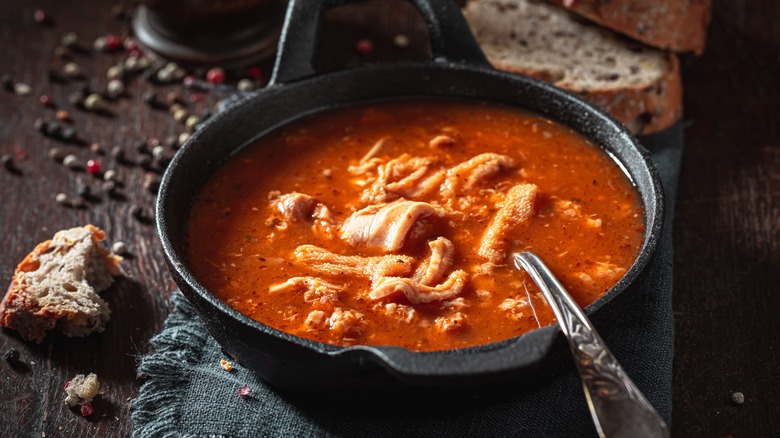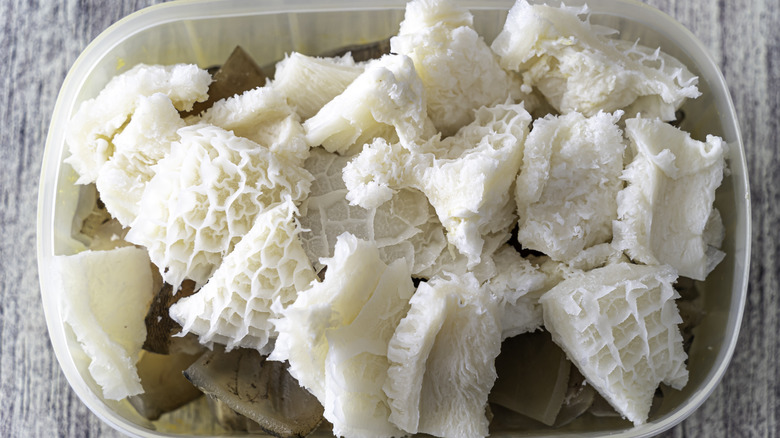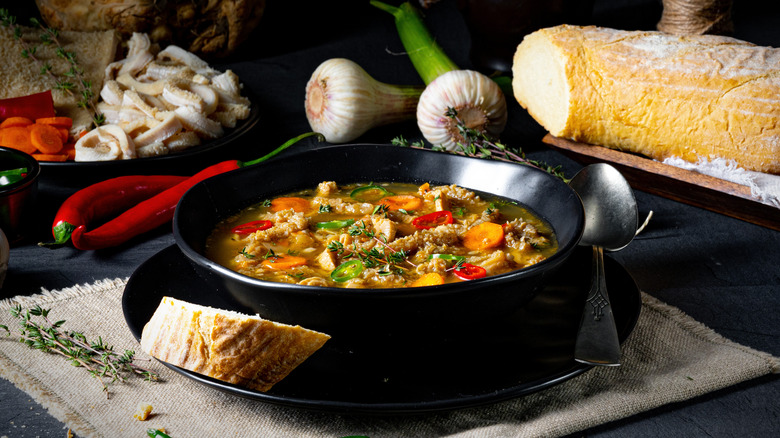Flaki Is The Polish Soup That's Untraditionally Spicy
Flaki or flaczki may put off many eaters by name alone. The word translates to guts, and the ingredient-packed, strong-smelling soup isn't for every palate. But for those who appreciate a dense, flavorful bowl of spicy tripe — that's innard of beef for the uninitiated — this hearty Polish recipe can satisfy pangs of hunger and cravings for warm comfort. The soup has a reputation for curing hangovers, is often served at weddings, and has even garnered its own festival in the small town of Piaski, with devotees of the tradition flocking to sample different recipes from regional chefs.
Since the 14th century, tripe cooked in stock thickened with roux and flavored with saffron has graced the tables of kings and commoners alike. Unlike many dishes in Poland, it's richly spiced with ginger, nutmeg, pepper, and marjoram. This meaty recipe provides spoonfuls of aromatic broth that call for extra servings of crusty bread to sop up whatever is left in the bottom of your bowl.
Origins of flaki
Polish menus are often hearty and filling, and flaki is no exception. Tripe soup, however, isn't uniquely Polish, as similar bowls of rustic flavorful broth can be found ladled in multiple other countries, including Turkey, Ukraine, and Belarus, as well as Italy, Germany, and France. Yet flaki has become a traditional Polish dish and has earned its place as one of the more recognizable dishes served on menus.
Władysław II Jagiełło, Poland's king in the 14th century, was known to enjoy this soup, and though pre-made flaki can now be found sold in bottles and cans across the country, homemade recipes continue to reign supreme. Yet making tripe soup can be a laborious process, with tripe boiled for hours in stock. The stomach lining of beef is usually tough, requiring hours to grow tender — honeycomb, the most tender part, is often preferred for this recipe. An assortment of vegetables can be added to recipes, which might include celery root, parsley root, carrots, leeks, and onions, and the soup is always generously spiced.
Making and serving flaki
Tripe soup is not created equal in Poland, and different communities have made recipes with unique ingredients and additions. In Warsaw, the soup comes served with veal meatballs stirred into pots, while in eastern communities, green peas can be found mixed into the soup. Bread that has been soaked in butter and milk is used to thicken some recipes, and tomato paste is added to other soups, giving it a rich red color, though this inclusion has become a contentious choice. For vegans, an animal-free recipe has been created, substituting oyster mushrooms for tripe and using similar seasonings to the meaty soup.
Many chefs make the soup in advance, for the longer the ingredients sit together, the more aromatic and flavorful the dish becomes. This is a recipe that can be reheated but should always be served hot and is often accompanied by a glass of vodka and crusty bread.


